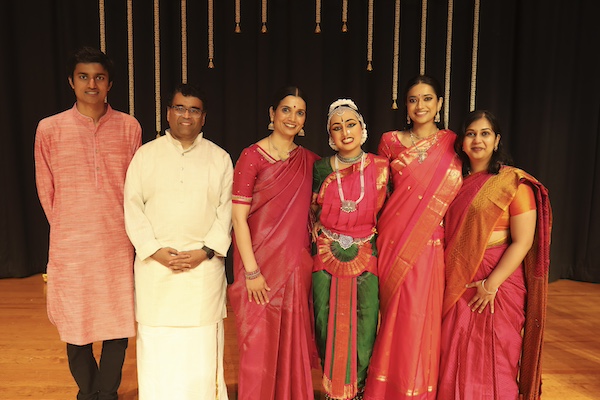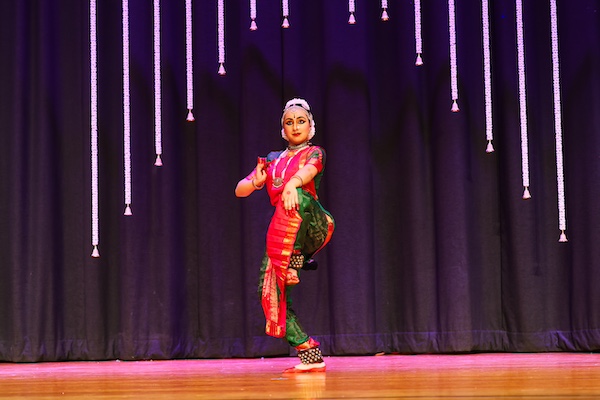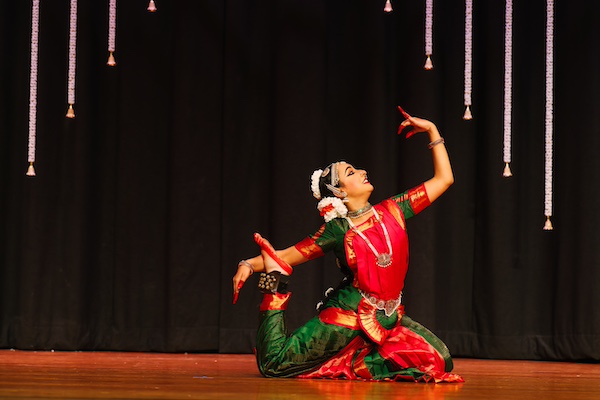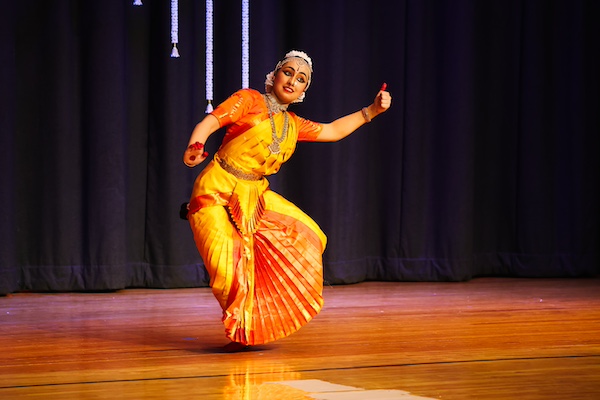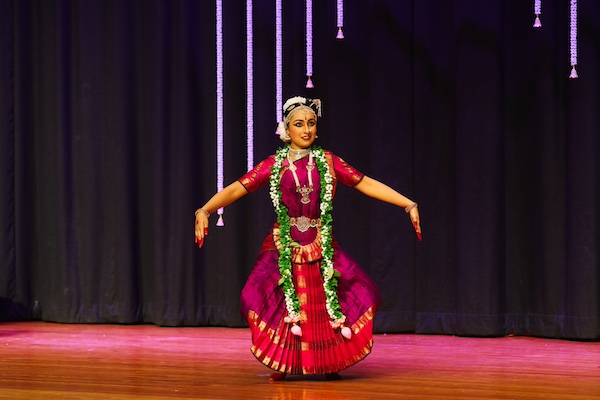Contribute
| Arangetram: Sumedha Giridharan |
Amrutha Ananth
07/31/2025
Sumedha’s Araṅkēṯṟam: An Offering in Movement Written by Amrutha Ananth There are debuts, and then there are moments that feel like a return: a return home to tradition, to devotion, and to self. On such an evocative evening, young Sumedha Giridharan, disciple of Ācārya Soumya Rajaram (Samskriti School of Dance), presented her Araṅkēṯṟam - a rich, contemplative journey through the classical Mārgam that felt like both a culmination and a beginning. From the moment guests arrived, they were drawn into a sacred space. The décor, inspired by a temple and framed by graceful silhouettes of classical dancers, featured kōlams, floral garlands, brass icons, and a beautifully adorned Dakṣiṇāmūrti — a symbolic nod to Bharatanāṭyam’s divine lineage. It wasn’t just visual charm but a thoughtful offering, where every element whispered that dance is both worship and wisdom. This immersive setting gently transported the audience from the mundane into the spiritual world Sumedha was about to unveil. Even the dinner tables echoed this vision, adorned with miniature temples and dancer motifs, allowing the sacred energy of the evening to linger long after the final bow. As tradition dictates, the program commenced with oblations to Lord Naṭarāja. When Acharya Soumya handed over the chalangai, it marked not just the start of a performance, but a rite of passage—infused with care, lineage, and love. The evening opened with “Karpaga Manōhara,” an invocation rendered by Sharmadha and Samyuktha Rajaram, setting a deeply devotional tone for what was to follow. The performance began with Puṣpāñjali in Rāgam Nāṭṭai and Ādi Thāḷam, structured as a Mallāri. Sumedha opened with reverent energy and poised movement, establishing the spiritual tenor of the evening. The orchestral ensemble—Mahathi Athreya’s crystal-clear vocals, Sharada Krishnan’s expressive violin, Anirudh Bharadwaj’s evocative flute, and Mali Santhanakrishnan’s masterful Mṛdaṅgam — offered a soundscape that was vibrant yet grounding, evoking the solemnity of a temple procession. This was followed by a ślokam in Rāgam - Vasanthā, drawn from Sakala Kalā Valli Mālai by Kumaraguruparar, in praise of Goddess Saraswati. With composed grace, Sumedha brought to life the spirit of the verse—not merely illustrating it through mudrās but embodying its essence. For those who know her well, the choice was particularly fitting: she truly is a Sakala Kalā Valli, with her affinity for dance, music, and books. Growing up with Sanskrit ringing through her home — thanks to her father, a brother trained in Mṛdaṅgam, a mother rooted in education, and a grandmother whose cooking is steeped in story and devotion—Sumedha’s portrayal of Saraswati felt effortless and full-circle. Mahathi’s fluid rendering of the Tamil verses added to the contemplative beauty of the piece. The Alārippu in Miśracāpu showcased Sumedha’s rhythmic precision. Her gaze was steady, her transitions sharp, and her control over timing remarkable. Mali’s Mṛdaṅgam, perfectly in sync with this seven-beat cycle, added intricate texture to the performance. In the Jathiswaram in Bahudhāri (Ādi Thāḷam), composed by Kangamani Vijayendra, Sumedha maintained excellent form through brisk jathi segments, showcasing her laya sensitivity. This piece—pure nṛtta —required focus and endurance, and Sumedha delivered both with clarity. The violin and flute followed the swaras with lyrical grace, offering her ample space to carve rhythmic geometry in motion. The Śabdam – Āyar Chēriyar (Rāgamālikā, Miśracāpu) brought Krishna’s world vividly to life. With sparkling abhinaya, Sumedha shifted easily between personas — from the mischievous child-God to the gopis, full of admiration. Her expressiveness was animated yet grounded in classicism, and Anirudh’s playful flute runs provided a charming backdrop to the scenes she painted. Then came the emotional centerpiece of the evening—the Varnam: “Āṭkoḷḷa vēṇḍum aiyanē”, composed by G. Vijayaraghavan and set to music by K. Hariprasad. This demanding piece sees Āndāl pleading with Lord Ranganatha to accept her — a story filled with longing, surrender, and spiritual passion. Sumedha approached the role with heartfelt sincerity. Her silences were as eloquent as her movements, and her eyes conveyed a depth of emotion that seemed beyond her years. As I watched her, I was reminded of Āndāl Āndāl, the striking production by Anita Ratnam and Pritha Ratnam, which I had witnessed and written about over a decade ago during the Chennai Mārgazhi season (read here). That performance had stayed with me for its poetic layering and feminine voice. And here was little Sumedha—unflinching in energy and grace—evoking the same timeless yearning through simplicity and sincerity. The jathis in this Varnam, choreographed by Soumya Rajaram, were distinctive—not traditional Kalakshetra blocks, but newly imagined rhythmic patterns that challenged both dancer and orchestra. The final thīrmānam — layered, breathless, and synchronized — earned a spontaneous burst of applause. After a brief intermission, the second half resumed with “Gopālaka Pāhimam” in Revagupti, composed by Swathi Thirunal. Here, Sumedha softened her approach, portraying Krishna not as the mischievous deity but as the kind protector. Her expressions had a gentle luminosity, her movements warm and fluid, giving the audience space to breathe and reflect. Next came “Ārabhimānam”, a Rāgamālikā Kīrtanam in Ādi Thāḷam, a vibrant praise of Goddess Parvati. As each raga unfurled— Kalyāṇi, Bhairavi, Lalitā, and more — Sumedha brought forth their corresponding manifestations: Kalyani, the auspicious; Bhairavi, the fierce; Lalitāambā, the graceful. Each transition was like a glimpse into a sanctum, with sculptural poses steeped in emotion. This was not merely a sequence of melodies and movements—it was a journey through the intertwining of raga, rasa, and rupa, the spiritual DNA of Bharatanāṭyam. In “Nēṯṟanthi nērattilē”, a Padam in Huseni by Subbarama Iyer, Sumedha portrayed a Vipralabdha Nāyikā — a woman hurt and jealous after witnessing her beloved Lord Muruga with another woman at the riverbank at dusk. The padam describes her lament and her poignant questions: who was that other woman, and why did Muruga give her attention? This is no easy narrative — it requires subtlety, sarcasm, curiosity, and vulnerability. There was a quiet crescendo in Sumedha’s abhinaya — a slow unfolding of emotion with careful modulation. Her face flickered with suspicion, softened into affection, then darkened with quiet disappointment. Her gestures were laden with feeling yet never overplayed. A mere tilt of the head, a quick glance, said volumes. For a young dancer, it was an impressively restrained and emotionally intelligent interpretation. The recital concluded with a Thillānā in Hamsānandi, composed by Dandayudhapani Pillai, in praise of Lord Naṭarāja of Chidambaram. A joyful celebration of rhythm and form, this piece allowed Sumedha to dance with abandon. With bright aḍavus, precise kōrvais, and radiant energy, she offered a jubilant close to a journey that had moved from invocation to inquiry to inner radiance. Throughout the performance, the orchestra served as more than accompaniment — they were collaborators in spirit. Mahathi Athreya brought lyrical depth and emotive phrasing, gliding with ease across styles. Sharada Krishnan, student of Vidwan Lalgudi G.R. Krishnan, provided sensitive melodic textures. Anirudh Bharadwaj, disciple of Vidwan Delhi Sunderrajan, shaped his flute phrases with empathy and elegance. Mali Santhanakrishnan, a seasoned mṛdaṅgist and founding member of KHMC, anchored every item with intuitive understanding, giving the dancer space to shine. As rightly acknowledged by chief guest Aparna Balaji and guest of honor Preetha Arun, each member of the orchestra is a stalwart in their own right—and their synergy lent the evening its polish and soul. At the heart of it all stood Ācārya Soumya Rajaram—not just as a teacher of technique, but as a guide to grace, discipline, and humility. Her touch was visible in every nuance, and her disciple carried it with deep reverence. Sumedha’s Araṅkēṯṟam was not merely a performance. It was a prayer in motion, a garland of learning, faith, and blossoming artistry—offered at the altar of tradition. I wish her every success and many more inspiring journeys ahead.
You may also access this article through our web-site http://www.lokvani.com/

